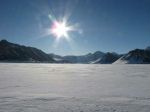
A chronograph used to make a time-record of certain measured meteorological elements. The most common type, the triple register, records wind direction and speed, duration of sunshine, and amount of rainfall (sensed respectively by a contact anemometer, M ...

